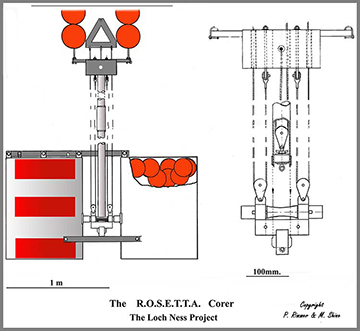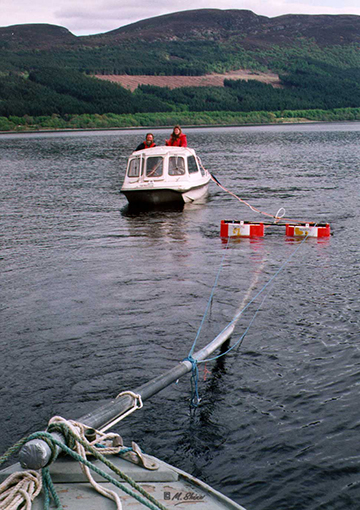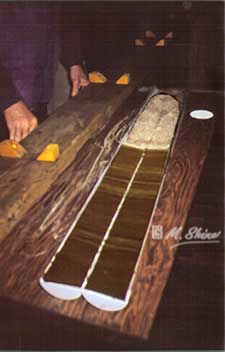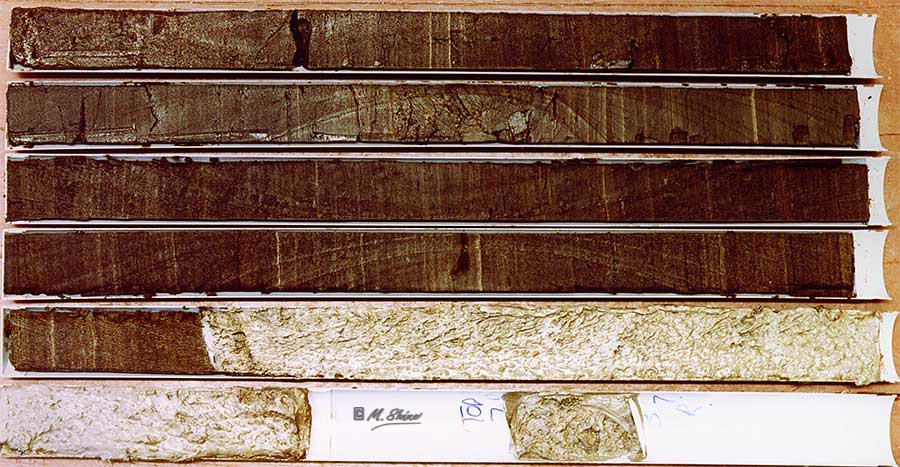Project

The great depths of Loch Ness provide an especially stable resting place for the rain of particles from above. In shallower lakes, the silt can be re-suspended by water currents thus blurring the sequences but in Loch Ness the sediments build an undisturbed time capsule of events within the lake, the surrounding catchment and much further afield. Studies of cores recovered by the Loch Ness Project's ROSETTA corer have provided a variety of information.
Adrian Shine designed the ROSETTA project in order to operate a long core barrel at a depth of 230m. He hoped to retrieve a 12m core that would retrieve thousands of years of sediment and hopefully, reveal glacial clay at the base.

The core 12m stainle3ss steel barrel was designed to be taken to the bottom of the loch between dual anchor chambers which were fabricated in Inverness. The rig was then towed to the chosen site with the Project's boat 'Ecos'. The core tube was stationed between and above the anchor chambers and attached to them by a pulley system. the whole rig was attached to a one ton lift bag deployed 20m below the surface of th ewater.. Before lowering the rig to the bottom, the air in the anchore chambers had to be bled allowing the rig a swift and steady descent. On reaching the loch bed , water was pumped out of the anchor chambers to create a vacuum to clamp them in place. Then the one ton lift bag was inflated with compressed air. The one ton of lift triggered the rig at the loch bed and thereby forced the core barrel into the sediment by means of the activated pulley system . Once the core barrel had reached it's full depth in the sediment the lift bag then slowly pulled the anchor chambers clear of the sediment. The lift bag slowly rose to the surface with the ROSETTA rig hanging around 200m below, but clear of the loch bed.
It's necessary to raise the rig as quickly as possible in order not to leak any sediment out of the core barrel. So next came the tricky job of forcing compressed air into the anchor chanbers in order to bring everything back to the surface. It was with some relief that we saw the red and white anchore chambers bob to the surface and we began the long haul back to base. The project took 24 hours to complete and it wasn't until the extrusion that the team could be sure of their success.

As the sediment was extruded it slowly became clear that it was a successful sampling. The sediment showed ten thousands years of seasonal layers (varves) . Better still, the organic brown and green layers abruptly changed to grey ish white clay, we were seeing the end of the Ice Age! Success! The core was carefully sealed and sent for analysis to many universities in the UK and internationally.
Working in 230m of water with compressed gas and heavy steel equipment has it's dangers and not something undertaken lightly. The first 12m core barrel attempt had failed and the core tube was retrieved with it's steel wires bent and broken by the intense pressures down there. It's possible that the core tube had hit so much clay that it became embedded to deeply. The strain of the lift bag in pulling it out possibly caused fittings to fail and wire to break.
The second attempt with the 6m core barrel hit the clay but probably because it was a shorter barrel it was easier for the physics to pull it out without too much twanging and snapping going on. Another worry was that the 6m steel core tube would surface too quickly and possibly hit and seriously damage the two boats managing the project the surface. The ROSETTA corer was a prototype necessarily entailing known and unknown issues, not least was the difficulty of finding a weather window. The difficulty at Loch Ness is always finding a calm day that stays calm long enough to assemble a crew.
The corer however, was a great success and though the physics that propelled the corer deep into the sediment isn't rocket science, Loch Ness Project always considered it to be their moon shot.
.


The sediment
Most of the sediment comes into the loch over winter due to the increased rainfall and consists of particles of decaying vegetation which has grown along the river banks. This pattern together with the different settling rates of organic and mineral particles produces distinct colour bands or "laminations". As the key to these laminations is deciphered, they will provide a history of change since the Ice Age and also the environmental impact of human activities. For example, in summer there is an increase in microscopic plants called Diatoms. They have silica cases which endure, locked in the sediment and can be identified. Since the requirements of many species are known with regard to temperature, nutrient richness and acidity, it is possible to reconstruct a quite detailed picture of conditions over time.
Two of today's concerns over lakes are the effects of acid rain and nutrient enrichment (eutrophication). Work at University College London shows that despite considerable levels of sulphur deposition from atmospheric contamination, the loch has been buffered against acidification. On the other hand, there are no grounds for complacency. Increases in the proportion of open water Diatoms as opposed to shoreline ones, point to a small enrichment probably due to human settlements and agriculture.
Other work traces the increase of heavy metal inputs from industrialisation together with carcinogenic chemicals such as PCBs and PAHs. Radioactive isotope analysis shows clearly the shadow of the 1963 peak in atmospheric nuclear bomb testing and just 4cm down the fall-out from the Chernobyl accident of 1986.
In fact the rapid decay of a naturally occurring isotope called Lead 210, is helpful in dating events over the last 150 years. Through this approach, it seems that a mysterious clay layer, about 30cms down in the sediment, results from powerful erosion during a great flood in 1868. In 1993, a hundred and twenty five years later, work on cores suggests that so much water and silt came down the rivers into Urquhart bay that an underwater avalanche was triggered, spreading a deposit of sand out into the loch. Ultimately the finer clay particles settled to blanket the deep basin thus providing a "marker layer" and enabling the rapid dating of other cores.
The longer cores contain almost indestructible pollen grains which are now shedding light on the history of vegetation around the loch since the ice retreated and advanced in a tundra landscape 10,000 years ago. Then forests grew up and were cut down as man began farming in the glen. Finally, the new forestry plantations were established. Seismic work shows that the sediments are at least 20m deep, guaranteeing the scientific importance of the site. It may even conceal sediments laid down before the last glaciation.
This page copyright Shine, LNP